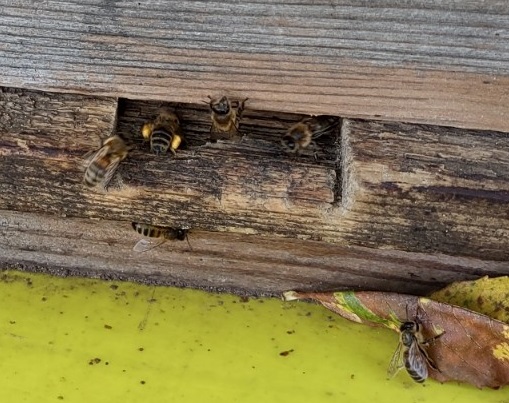 Abraham Lincoln
If given the truth, the people can be depended upon to meet any national crisis...
Abraham Lincoln
If given the truth, the people can be depended upon to meet any national crisis...
 Guildford news...
for Guildford people, brought to you by Guildford reporters - Guildford's own news service
Guildford news...
for Guildford people, brought to you by Guildford reporters - Guildford's own news service
Beekeeper’s Notes: Spectacular Autumn Is Here And A Caterpillar Being Eaten By Fly Maggots
Published on: 1 Nov, 2022
Updated on: 31 Oct, 2022
Hugh Coakley keeps bees in Worplesdon
The weather is drawing in, shorter days and a little bit colder and wetter. Just what we would expect and even hope for at this beautiful time of year.
We love autumn and it’s already looking great. The Winkworth Arboretum, founded with the spectacular autumn displays in mind, is so busy, I hear you have to book to visit.
Our hives are prepared for the long winter. Plenty of honey for the bees to last them through to next March.
All except one, which for some reason, appears to be a bit light on stores and we have fed it to make sure it can survive. When training, we were asked to lift up one side of a hive box which had been filled with heavy bricks. “That’s how heavy your hive should feel” leading up to the colder seasons, we were told. It is called hefting a hive and it’s a useful and simple way of judging if your bees are well stocked.
A random observation. We saw on our conservatory door what we think is a “cabbage” white butterfly caterpillar being eaten alive by a tiny fly and it’s progeny.

A “cabbage” white caterpillar being eaten by fly maggots. Two weeks later, the caterpillar had been devoured. Photographed on a glass door.
Meanwhile, on warmer days the bees are very active flying.
They are still bringing in the four items on their 20 million-year-old unvaried shopping list; nectar, pollen, water and tree sap, whenever they can.
Nectar to convert to honey, their food. Less now but there are still some sources in gardens and on things like ivy, surprisingly.
Pollen to provide protein to the decreasing number of eggs and larvae in the hive.
Water to drink. We all need water.
And tree sap. The bees convert it into propolis, a sticky antiseptic substance which they use to line the cells before the queen lays her eggs but also used to block up gaps in their nest. Traditionally, people would rub propolis on their gums for some relief if they had a toothache.
Isn’t nature fascinating?

Click on cartoon for Dragon story: Public Asked for Views on SCC’s Proposal for Reduced Speed Limits



Recent Articles
- Charlotteville Cycle Club Organises Another Successful Cycle Race Event
- Waverley Council To Bring Green Space Maintenance In-house
- A New Dementia Centre for Guildford
- Lib Dems Easily Hold Three Council Seats in Surrey By-elections
- UK Students to Launch International Space Mission
- New Skate Park Proposed for Cranleigh
- Retrofit Planned for Guildford Office Building
- Museum Shines a Light on Victorian Send, Ripley and Pyrford
- Guildford Festival Burst with Colour, Culture and Community Spirit
- Conservationists Celebrate Victory As Fast-food Plan At Nature Reserve Is Turned Down



Search in Site
Media Gallery
Dragon Interview: Local Artist Leaves Her Mark At One of England’s Most Historic Buildings
January 21, 2023 / No Comment / Read MoreDragon Interview: Lib Dem Planning Chair: ‘Current Policy Doesn’t Work for Local People’
January 19, 2023 / No Comment / Read MoreA3 Tunnel in Guildford ‘Necessary’ for New Homes, Says Guildford’s MP
January 10, 2023 / No Comment / Read More‘Madness’ for London Road Scheme to Go Ahead Against ‘Huge Opposition’, Says SCC Leader
January 6, 2023 / No Comment / Read MoreCouncillor’s Son Starts Campaign for More Consultation on North Street Plan
December 30, 2022 / No Comment / Read MoreCounty Council Climbs Down Over London Road Works – Further ‘Engagement’ Period Announced
December 14, 2022 / No Comment / Read MoreDragon Interview: GBC Reaction to the Government’s Expected Decision to Relax Housing Targets
December 7, 2022 / No Comment / Read MoreHow Can Our Town Centre Businesses Recover? Watch the Shop Front Debate
May 18, 2020 / No Comment / Read More








Recent Comments